The constant current regulator market's trajectory from USD 2.1 billion in 2025 to USD 3.5 billion by 2035 represents substantial expansion, with a forecast CAGR of 5.1%. This growth demonstrates the accelerating adoption of advanced current control technologies and growing investment in electronic systems infrastructure across consumer electronics, industrial control, and automotive applications worldwide.
The market operates within a dynamic landscape characterized by expanding electronic device proliferation, power management system modernization initiatives, and growing demand for precise current regulation across consumer electronics, industrial automation, and automotive electronics applications. Market dynamics reflect increasing investment in power management infrastructure, accelerating adoption of advanced current control equipment, and rising demand for versatile regulation solutions that support diverse electronic systems and power conversion methodologies.
Electronic system procurement patterns demonstrate shifting preferences toward multi-functional current regulation systems that combine precision control, switching capabilities, and programmable features. Consumer electronics manufacturers and industrial control system providers prioritize equipment reliability, current stability, and operational efficiency when selecting regulation solutions for critical applications including LED lighting, motor control, power conversion, and electronic device management procedures.
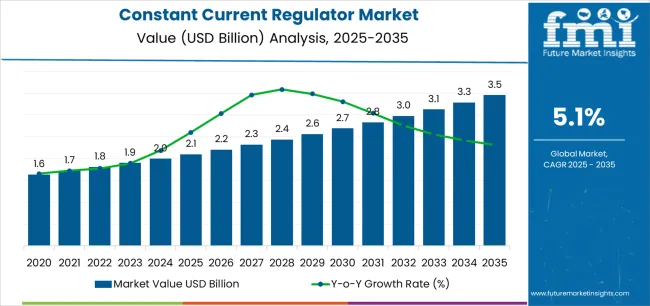
The market benefits from expanding electronics manufacturing activities across consumer, industrial, and automotive sectors, driving demand for sophisticated current control equipment that enables complex electronic system operations. Growing emphasis on power efficiency and system reliability creates opportunities for manufacturers offering validated regulation systems with comprehensive performance capabilities and quality assurance features.
Technology advancement influences market evolution through integration of switching control systems, digital monitoring capabilities, and enhanced efficiency features that improve electronic system performance and operational outcomes. Manufacturers focus on developing regulation solutions that accommodate varying current requirements, voltage ranges, and control parameters while maintaining precise current delivery throughout extended operation periods.
The constant current regulator market demonstrates strong growth fundamentals driven by expanding electronics applications, power management infrastructure development, and increasing demand for precision current control equipment across multiple electronic disciplines and industrial applications.
The first half of the decade (2025-2030) will witness market growth from USD 2.1 billion to approximately USD 2.6 billion, adding USD 0.5 billion in value, representing 34% of the total forecast period expansion. This phase will be characterized by rapid adoption of switching control systems, driven by electronics modernization programs and increasing demand for programmable regulation solutions across consumer and industrial applications.
The latter half (2030-2035) will experience accelerated growth from USD 2.6 billion to USD 3.7 billion, representing an addition of USD 1.0 billion or 66% of the decade's expansion. This period will be defined by mass market penetration of advanced constant current regulator technologies, integration with electronic system management platforms, and seamless connectivity with existing power infrastructure.
| Period | Primary Revenue Buckets | Share | Notes |
|---|---|---|---|
| Today | Linear regulators (consumer, industrial) | 62% | Traditional configurations, established facilities |
| Switching systems | 31% | Compact installations, specialized applications | |
| Custom & hybrid systems | 7% | Premium installations, specialized electronics | |
| Future (3-5 yrs) | Advanced linear systems | 58-61% | Enhanced efficiency, digital controls |
| High-efficiency switching systems | 32-35% | Industrial complexes, production facilities | |
| Consumer electronics applications | 28-32% | LED lighting, mobile devices | |
| Industrial control applications | 25-29% | Motor control, automation systems | |
| Automotive electronics applications | 22-26% | Vehicle systems, charging infrastructure | |
| LED lighting systems | 15-19% | Commercial lighting, display systems | |
| Specialized applications | 8-12% | Custom electronics, industrial testing |
| Metric | Value |
|---|---|
| Market Value (2025) | USD 2,119.2 million |
| Market Forecast (2035) | USD 3,689.1 million |
| Growth Rate | 5.7% CAGR |
| Leading Type | Linear Constant Current Regulators |
| Primary Application | Consumer Electronics Segment |
The market demonstrates strong fundamentals with linear regulator systems capturing dominant share through advanced current control and electronics application optimization. Consumer electronics applications drive primary demand, supported by increasing device proliferation and electronic system expansion initiatives. Geographic distribution remains concentrated in developed markets with established electronics infrastructure, while emerging economies show accelerating adoption rates driven by manufacturing modernization programs and rising electronics investment.
Primary Classification: The market segments by type into linear and switching systems, representing evolution from traditional current regulation to sophisticated current-controlled switching technologies for comprehensive electronics power management optimization.
Secondary Classification: Application segmentation divides the market into consumer electronics, industrial control, automotive electronics, LED lighting, and others, reflecting distinct requirements for current ranges, switching parameters, and electronic system specifications.
Tertiary Classification: End-use segmentation covers electronics manufacturers, industrial equipment providers, automotive suppliers, lighting system integrators, and power management facilities, while distribution channels span direct sales, electronics component distributors, and specialized power management equipment suppliers.
Regional Classification: Geographic distribution covers North America, Latin America, Western Europe, Eastern Europe, East Asia, South Asia Pacific, and Middle East & Africa, with developed markets leading adoption while emerging economies show accelerating growth patterns driven by electronics manufacturing infrastructure development programs.
The segmentation structure reveals technology progression from traditional current regulation toward sophisticated current-controlled switching systems with enhanced efficiency capabilities, while application diversity spans from basic electronics to specialized power management procedures requiring precise current control solutions.
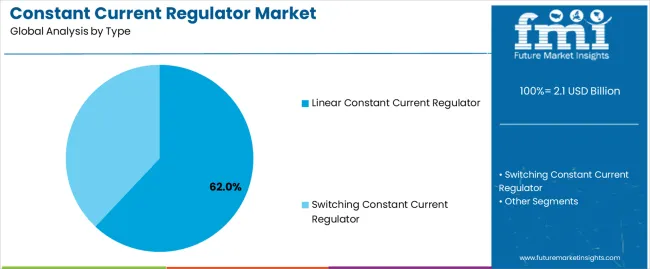
Market Position: Linear constant current regulator systems command the leading position in the constant current regulator market with 62% market share through proven current control technologies, including efficient current delivery, reliable regulation mechanisms, and electronics performance optimization that enable system operators to achieve optimal power management conditions across diverse consumer and industrial environments.
Value Drivers: The segment benefits from electronics facility preference for cost-effective regulation systems that provide consistent current control, operational reliability, and system flexibility without requiring complex switching designs. Advanced linear processing features enable enhanced current stability, precise regulation control, and integration with existing electronics systems, where power precision and process reliability represent critical operational requirements.
Competitive Advantages: Linear constant current regulator systems differentiate through proven operational reliability, simple installation characteristics, and integration with established electronics management systems that enhance system effectiveness while maintaining optimal power standards suitable for diverse electronic applications.
Key market characteristics:
Switching constant current regulator systems maintain a 31% market position in the constant current regulator market due to their high-efficiency configuration advantages and advanced power conversion benefits. These systems appeal to facilities requiring high-performance regulation solutions with enhanced efficiency profiles for production-scale operations. Market growth is driven by industrial facility expansion, emphasizing high-efficiency regulation solutions and operational excellence through optimized power management designs.
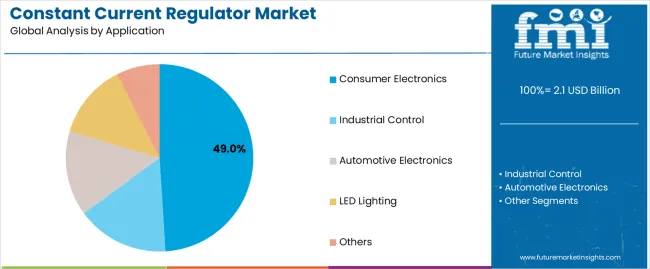
Market Context: Consumer electronics applications demonstrate strong growth in the constant current regulator market with a 49% share, driven by the widespread adoption of LED technologies and an increasing focus on mobile device power management, display systems, and portable electronics applications that maximize power efficiency while maintaining device performance integrity standards.
Appeal Factors: Electronics manufacturers prioritize system reliability, current precision, and integration with existing power infrastructure that enables coordinated device operations across multiple electronic protocols. The segment benefits from substantial consumer electronics investment and technology development programs that emphasize acquisition of advanced regulation systems for LED optimization and mobile device applications.
Growth Drivers: Electronics manufacturing programs incorporate current regulators as essential components for LED operations, while consumer device development increases demand for regulation capabilities that comply with efficiency standards and minimize power variability.
Market Challenges: Varying device protocols and power requirement complexity may limit system standardization across different manufacturing facilities or electronic scenarios.
Application dynamics include:
Industrial control applications capture 27% market share through motor control requirements in manufacturing facilities, automation testing operations, and industrial research applications. These facilities demand high-performance regulation systems capable of supporting industrial protocols while providing current precision and operational reliability capabilities.
Automotive electronics applications account for 24% market share, including vehicle control systems, charging infrastructure, and automotive development operations requiring precise regulation capabilities for electronic system analysis and vehicle performance optimization.
How Do Electronics Manufacturers Drive Market Leadership in Constant Current Regulators?
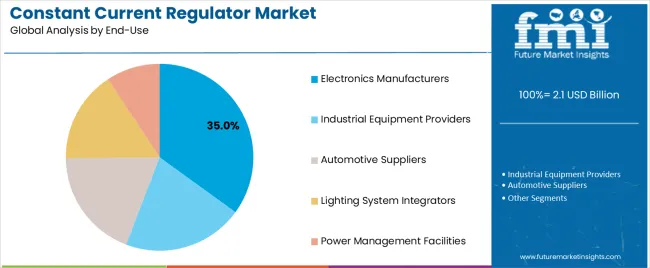
Market Context: Electronics manufacturers dominate the market with a 35% share, reflecting their role as the primary demand source for constant current regulator technology in consumer device production and system optimization.
Business Model Advantages: Electronics Manufacturers provide direct market demand for standardized regulation systems, driving volume production and cost optimization while maintaining precision control and performance consistency requirements.
Operational Benefits: Electronics Manufacturer applications include system optimization, production efficiency, and performance assurance that drive consistent demand for regulation systems while providing access to latest current regulator technologies.
| Category | Factor | Impact | Why It Matters |
|---|---|---|---|
| Driver | Electronics proliferation & LED adoption (consumer devices, lighting systems) | ★★★★★ | Growing electronics market requires advanced regulation systems with enhanced current control capabilities and precision properties proven effective across electronics applications. |
| Driver | Industrial automation & power management advancement (motor control, system efficiency) | ★★★★★ | Transforms power requirements from "basic regulation" to "precision current control"; operators that offer advanced regulation systems and monitoring features gain competitive advantage. |
| Driver | Automotive electronics & vehicle electrification (electric vehicles, charging systems) | ★★★★☆ | Modern automotive systems need sophisticated, efficient regulation systems; demand for automotive and electrification solutions expanding addressable market. |
| Restraint | High system cost & complexity constraints (especially for basic applications) | ★★★★☆ | Smaller electronics facilities defer regulation system upgrades; increases price sensitivity and slows advanced equipment adoption in cost-conscious markets. |
| Restraint | Alternative power management competition (voltage regulators, power supplies) | ★★★☆☆ | Traditional power alternatives offer established supply chains and lower costs, potentially limiting current regulator adoption in conventional applications. |
| Trend | Smart control integration & efficiency enhancement (digital monitoring, power analytics) | ★★★★★ | Advanced control properties, efficiency optimization, and data analytics transform operations; technology integration and performance enhancement become core value propositions. |
| Trend | System connectivity & remote monitoring (IoT integration, cloud-based systems) | ★★★★☆ | Smart regulation systems for specific applications and protocols; specialized monitoring and targeted optimization capabilities drive competition toward connected solutions. |
The constant current regulator market demonstrates varied regional dynamics with Growth Leaders including China (7.7% growth rate) and India (7.1% growth rate) driving expansion through electronics manufacturing development and power management modernization initiatives. Steady Performers encompass Germany (6.6% growth rate), Brazil (6.0% growth rate), and developed regions, benefiting from established electronics facilities and industrial automation sector growth. Mature Markets feature United States (5.4% growth rate), United Kingdom (4.8% growth rate), and Japan (4.3% growth rate), where electronics advancement and power optimization requirements support consistent growth patterns.
Regional synthesis reveals East Asian markets leading adoption through electronics expansion and manufacturing development, while North American countries maintain steady expansion supported by industrial automation advancement and electronics infrastructure investment. European markets show strong growth driven by automotive applications and power integration trends.
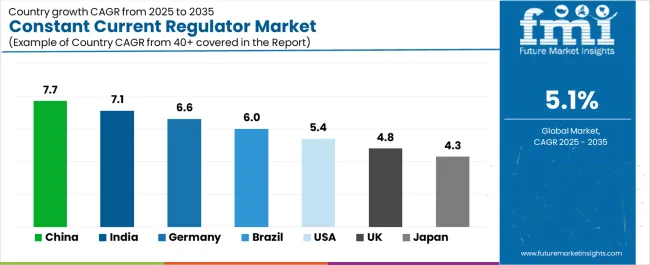
| Region/Country | 2025-2035 Growth | How to win | What to watch out |
|---|---|---|---|
| China | 7.7% | Focus on cost-effective electronics solutions | Regulatory changes; local competition |
| India | 7.1% | Lead with precision control systems | Import restrictions; infrastructure barriers |
| Germany | 6.6% | Provide premium automotive systems | Over-regulation; lengthy approvals |
| Brazil | 6.0% | Offer value-oriented solutions | Currency fluctuations; import duties |
| United States | 5.4% | Push technology integration | Compliance costs; scaling challenges |
| United Kingdom | 4.8% | Focus on industrial applications | Economic impacts; funding constraints |
| Japan | 4.3% | Emphasize precision manufacturing | Traditional preferences; adoption rates |
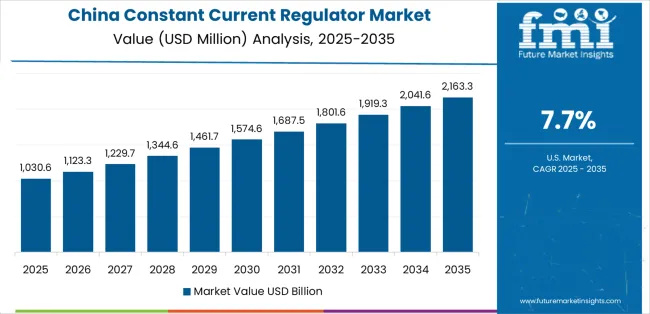
China establishes fastest market growth through aggressive electronics manufacturing development programs and comprehensive industrial facility expansion, integrating advanced constant current regulator systems as standard components in electronics production and manufacturing institutions. The country's 7.7% growth rate reflects government initiatives promoting electronics infrastructure and domestic technology capabilities that mandate use of precision regulation systems in consumer electronics and industrial manufacturing facilities. Growth concentrates in major manufacturing hubs, including Shenzhen, Shanghai, and Guangzhou, where electronics development showcases integrated power systems that appeal to manufacturers seeking current precision capabilities and production applications.
Chinese manufacturers are developing cost-effective regulation solutions that combine domestic production advantages with advanced current features, including enhanced power control and improved efficiency capabilities. Distribution channels through electronics equipment suppliers and manufacturing facility integrators expand market access, while government support for electronics development supports adoption across diverse consumer and industrial segments.
Strategic Market Indicators:
In Mumbai, Delhi, and Bangalore, electronics facilities and manufacturing operators are implementing constant current regulator systems as standard equipment for production optimization and system efficiency applications, driven by increasing government industrial investment and electronics development programs that emphasize importance of precision power capabilities. The market holds a 7.1% growth rate, supported by government manufacturing initiatives and industrial modernization programs that promote advanced regulation systems for electronics and manufacturing facilities. Indian operators are adopting regulation systems that provide consistent current precision and performance features, particularly appealing in urban regions where production optimization and system excellence represent critical manufacturing requirements.
Market expansion benefits from growing electronics capabilities and international technology partnerships that enable domestic production of advanced regulation systems for consumer and industrial applications. Technology adoption follows patterns established in power equipment, where precision and performance drive procurement decisions and operational deployment.
Market Intelligence Brief:
Advanced electronics market in Germany demonstrates sophisticated constant current regulator deployment with documented precision effectiveness in automotive applications and industrial facilities through integration with existing power systems and manufacturing infrastructure. The country leverages engineering expertise in power technologies and precision systems integration to maintain a 6.6% growth rate. Industrial centers, including Bavaria, Baden-Württemberg, and North Rhine-Westphalia, showcase premium installations where regulation systems integrate with comprehensive power platforms and facility management systems to optimize production efficiency and system effectiveness.
German manufacturers prioritize system quality and EU compliance in power development, creating demand for premium systems with advanced features, including facility integration and data management systems. The market benefits from established industrial infrastructure and willingness to invest in advanced power technologies that provide long-term operational benefits and compliance with international manufacturing standards.
Market Intelligence Brief:
Brazil's market expansion benefits from diverse electronics demand, including industrial modernization in São Paulo and Rio de Janeiro, manufacturing facility upgrades, and government industrial programs that increasingly incorporate precision regulation solutions for production applications. The country maintains a 6.0% growth rate, driven by rising industrial activity and increasing recognition of current precision benefits, including accurate power control and enhanced production effectiveness.
Market dynamics focus on cost-effective regulation solutions that balance precision performance with affordability considerations important to Brazilian manufacturing operators. Growing industrial development creates continued demand for modern regulation systems in new electronics infrastructure and facility modernization projects.
Strategic Market Considerations:
United States establishes market leadership through comprehensive electronics programs and advanced industrial infrastructure development, integrating constant current regulator systems across consumer electronics and industrial applications. The country's 5.4% growth rate reflects established manufacturing relationships and mature power technology adoption that supports widespread use of precision regulation systems in electronics and industrial facilities. Growth concentrates in major manufacturing centers, including California, Texas, and North Carolina, where power technology showcases mature deployment that appeals to manufacturers seeking proven precision capabilities and production optimization applications.
American electronics providers leverage established distribution networks and comprehensive technical support capabilities, including system design programs and training support that create customer relationships and operational advantages. The market benefits from mature regulatory standards and manufacturing requirements that mandate regulation system use while supporting technology advancement and production optimization.
Market Intelligence Brief:
United Kingdom's electronics market demonstrates integrated constant current regulator deployment with documented precision effectiveness in industrial applications and manufacturing facilities through integration with existing power systems and production infrastructure. The country maintains a 4.8% growth rate, supported by manufacturing efficiency programs and production effectiveness requirements that promote precision regulation systems for industrial applications. Manufacturing facilities across England, Scotland, and Wales showcase systematic installations where regulation systems integrate with comprehensive power platforms to optimize precision and production outcomes.
UK manufacturing providers prioritize system reliability and industrial compatibility in regulation procurement, creating demand for validated systems with proven precision features, including performance monitoring integration and data management systems. The market benefits from established manufacturing infrastructure and quality requirements that support power technology adoption and production effectiveness.
Market Intelligence Brief:
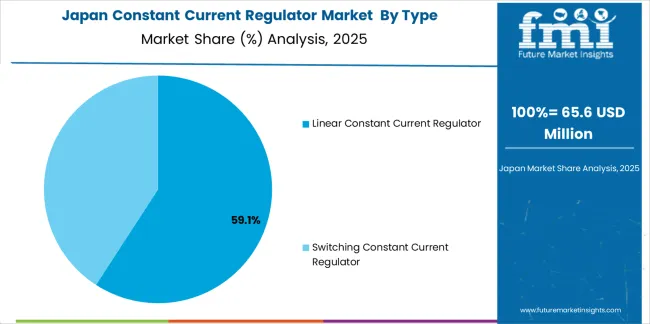
Japan's market growth benefits from precision electronics demand, including advanced manufacturing facilities in Tokyo and Osaka, quality integration, and precision enhancement programs that increasingly incorporate regulation solutions for production applications. The country maintains a 4.3% growth rate, driven by manufacturing technology advancement and increasing recognition of precision regulation benefits, including accurate current control and enhanced production outcomes.
Market dynamics focus on high-precision regulation solutions that meet Japanese quality standards and precision effectiveness requirements important to manufacturing operators. Advanced power technology adoption creates continued demand for sophisticated regulation systems in electronics facility infrastructure and production modernization projects.
Strategic Market Considerations:
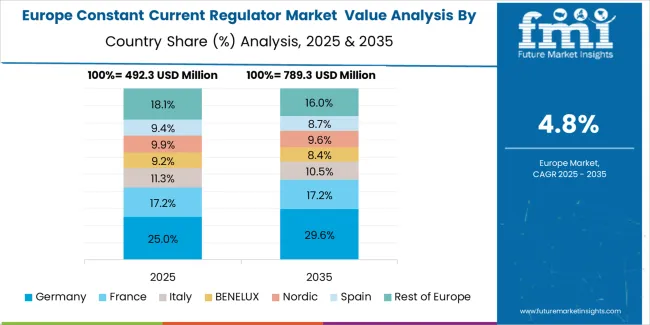
The European constant current regulator market is projected to grow from USD 403.8 million in 2025 to USD 592.1 million by 2035, registering a CAGR of 3.9% over the forecast period. Germany is expected to maintain its leadership position with a 38.7% market share in 2025, supported by its advanced automotive infrastructure and major electronics centers.
United Kingdom follows with a 26.4% share in 2025, driven by comprehensive industrial programs and manufacturing development initiatives. France holds a 18.3% share through specialized electronics applications and industrial compliance requirements. Italy commands a 9.2% share, while Spain accounts for 4.8% in 2025. The rest of Europe region is anticipated to gain momentum, expanding its collective share from 2.6% to 3.1% by 2035, attributed to increasing electronics adoption in Nordic countries and emerging manufacturing facilities implementing power modernization programs.
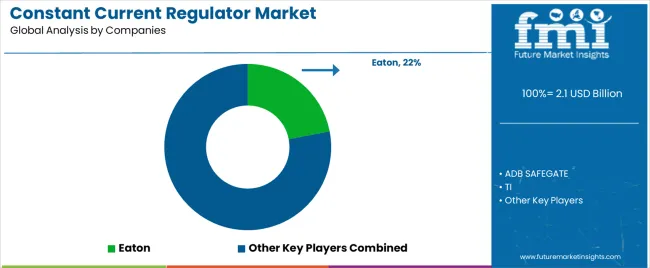
| Stakeholder | What they actually control | Typical strengths | Typical blind spots |
|---|---|---|---|
| Global brands | Distribution reach, broad product catalogs, brand recognition | Wide availability, proven precision, multi-region support | Product refresh cycles; customer dependency on brand validation |
| Technology innovators | Regulation R&D; advanced current technologies; enhanced efficiency properties | Latest technologies first; attractive ROI on precision effectiveness | Service density outside core regions; scaling complexity |
| Regional specialists | Local compliance, fast delivery, nearby customer support | "Close to customer" support; pragmatic pricing; local regulations | Technology gaps; talent retention in customer service |
| Full-service providers | Complete electronics programs, system integration, performance monitoring | Lowest operational risk; comprehensive support | Service costs if overpromised; technology obsolescence |
| Niche specialists | Specialized applications, custom systems, electronics services | Win premium applications; flexible configurations | Scalability limitations; narrow market focus |
| Item | Value |
|---|---|
| Quantitative Units | USD 2.1 billion |
| Type | Linear Constant Current Regulator, Switching Constant Current Regulator |
| Application | Consumer Electronics, Industrial Control, Automotive Electronics, LED Lighting, Others |
| End Use | Electronics Manufacturers, Industrial Equipment Providers, Automotive Suppliers, Lighting System Integrators, Power Management Facilities |
| Regions Covered | North America, Latin America, Western Europe, Eastern Europe, East Asia, South Asia Pacific, Middle East & Africa |
| Countries Covered | China, India, Germany, Brazil, United States, United Kingdom, Japan, Canada, France, Australia, and 25+ additional countries |
| Key Companies Profiled | Eaton, ADB SAFEGATE, TI, Infineon, Onsemi, Nasusystems, THYCON, Komachine, OCEM Airfield Technology |
| Additional Attributes | Dollar sales by type and application categories, regional adoption trends across East Asia, North America, and Western Europe, competitive landscape with electronics equipment manufacturers and system integrators, manufacturing operator preferences for current effectiveness and precision control, integration with electronics platforms and data management systems, innovations in regulation technology and current enhancement, and development of advanced regulation solutions with enhanced performance and system optimization capabilities. |
The global constant current regulator market is estimated to be valued at USD 2.1 billion in 2025.
The market size for the constant current regulator market is projected to reach USD 3.5 billion by 2035.
The constant current regulator market is expected to grow at a 5.1% CAGR between 2025 and 2035.
The key product types in constant current regulator market are linear constant current regulator and switching constant current regulator.
In terms of application, consumer electronics segment to command 49.0% share in the constant current regulator market in 2025.






Full Research Suite comprises of:
Market outlook & trends analysis
Interviews & case studies
Strategic recommendations
Vendor profiles & capabilities analysis
5-year forecasts
8 regions and 60+ country-level data splits
Market segment data splits
12 months of continuous data updates
DELIVERED AS:
PDF EXCEL ONLINE
Current Transducer Market Size and Share Forecast Outlook 2025 to 2035
Current Sensors Market Trends – Growth & Forecast 2025-2035
Current Carrying Wiring Devices Market - Forecast through 2034
Current Calibrator Market
High Current Ion Implanter Market Size and Share Forecast Outlook 2025 to 2035
Microcurrent Facial Market Analysis & Forecast by Application, End-use, and Region Through 2035
Eddy Current Testing Market Growth – Size, Demand & Forecast 2025 to 2035
Fault Current Limiters Market Growth - Trends & Forecast 2025 to 2035
Optical Current Transformer Market Size, Growth, and Forecast 2025 to 2035
Dry Type Current Transformer Market Size and Share Forecast Outlook 2025 to 2035
3rd Rail Current Collector Market Size and Share Forecast Outlook 2025 to 2035
Residual Current Circuit Breaker Market Growth - Trends & Forecast 2025 to 2035
Wound Type Current Transformer Market Size and Share Forecast Outlook 2025 to 2035
Flexible AC Current Transmission System Market Size and Share Forecast Outlook 2025 to 2035
Hall-Effect Current Sensor Market Size and Share Forecast Outlook 2025 to 2035
Oil Immersed Current Transformer Market Size and Share Forecast Outlook 2025 to 2035
Magneto Optic Current Transformer Market Size and Share Forecast Outlook 2025 to 2035
High Voltage Direct Current (HVDC) Capacitor Market Size and Share Forecast Outlook 2025 to 2035
High Voltage Direct Current Power Supply Market Size and Share Forecast Outlook 2025 to 2035
Automotive Closed Loop Current Transducer Market Size and Share Forecast Outlook 2025 to 2035

Thank you!
You will receive an email from our Business Development Manager. Please be sure to check your SPAM/JUNK folder too.
Chat With
MaRIA